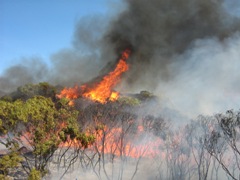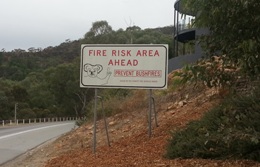24 September 2014
 The University of South Australia and University of Adelaide have joined forces for a new study to explore the balance between conservation values and bushfire risk in the Adelaide-Mount Lofty Ranges and Lower Eyre Peninsula.
The University of South Australia and University of Adelaide have joined forces for a new study to explore the balance between conservation values and bushfire risk in the Adelaide-Mount Lofty Ranges and Lower Eyre Peninsula.
With both these regions having experienced destructive bushfires causing loss of life and extensive property damage, study Chief Investigator UniSA’s Professor Guy Robinson says the management of vegetation for bushfire risk mitigation is crucially important.
The study will explore community perceptions of vegetation management regimes in peri-urban areas – areas where urban growth creates a hybrid landscape of fragmented urban and rural characteristics.
Prof Robinson, who is Director of UniSA’s Centre for Rural Health and Community Development and a Research Professor in the School of Natural and Built Environments, says catastrophic fires in peri-urban regions of Australia are reframing perceptions of what constitutes effective vegetation management.
“The Country Fire Service warns that South Australia can expect serious bushfires in six or seven out of every 10 years,” Prof Robinson says.
“In 1983, over 160,000 ha of the Adelaide-Mount Lofty Range were burnt and 28 fatalities recorded. The Lower Eyre Peninsula has recorded more recent fires, notably in 2005 where bushfires burnt over 77,000 ha and resulted in nine fatalities.”
Co-researcher Dr Douglas Bardsley from Geography, Environment and Population at the University of Adelaide has been researching the increasing vulnerability of human settlements on Adelaide’s peri-urban fringe.
“The increasing risk of bushfire on the fringes of Australian cities reflects a range of factors,” Dr Bardsley says.
“Urban spaces and individual dwellings are becoming increasingly embedded in fire-risk areas; suburban areas are becoming more wooded, and often planted with more flammable species.
“Extended droughts and more frequent heatwaves also increase the flammability of forests, woodlands, heathlands and grasslands within or near urban centres.”
Prof Robinson says the risks of dangerous bushfires in the urban fringe have the potential to restrict conservation outcomes.
 “This research project will examine community attitudes and concerns to provide recommendations that ensure future native vegetation management balances perceptions of fire risk against biodiversity value,” he says.
“This research project will examine community attitudes and concerns to provide recommendations that ensure future native vegetation management balances perceptions of fire risk against biodiversity value,” he says.
“Essentially we are seeking to balance two concerns: first, the threat of destructive bushfires occurring close to residential areas and, second, the need for effective conservation measures to maintain important and unique biodiversity.”
The research is being undertaken in partnership with the SA Government through the Department of Environment, Water, and Natural Resources (DEWNR) and two regional Natural Resource Management Boards (Adelaide-Mount Lofty Ranges and Eyre Peninsula).
The researchers will survey 3000 households this October and findings from the project will assist DEWNR and other policymakers with management of public responses to bushfire risk and conservation issues.
It will also guide the development of community engagement programs to enhance public awareness of bushfire risk, conservation, and the role of fire in maintaining biodiversity.
The project has been funded for three years by a $236,486 Australian Research Council Linkage grant and almost $1 million in partner cash and in-kind contributions.
Contact for interview: Chief Investigator Prof Guy Robinson (UniSA) mobile 0434 181 279
Dr Douglas Bardsley (University of Adelaide) mobile 0447 315 212
Media contact: Kelly Stone office 8302 0963 mobile 0417 861 832 email Kelly.stone@unisa.edu.au




